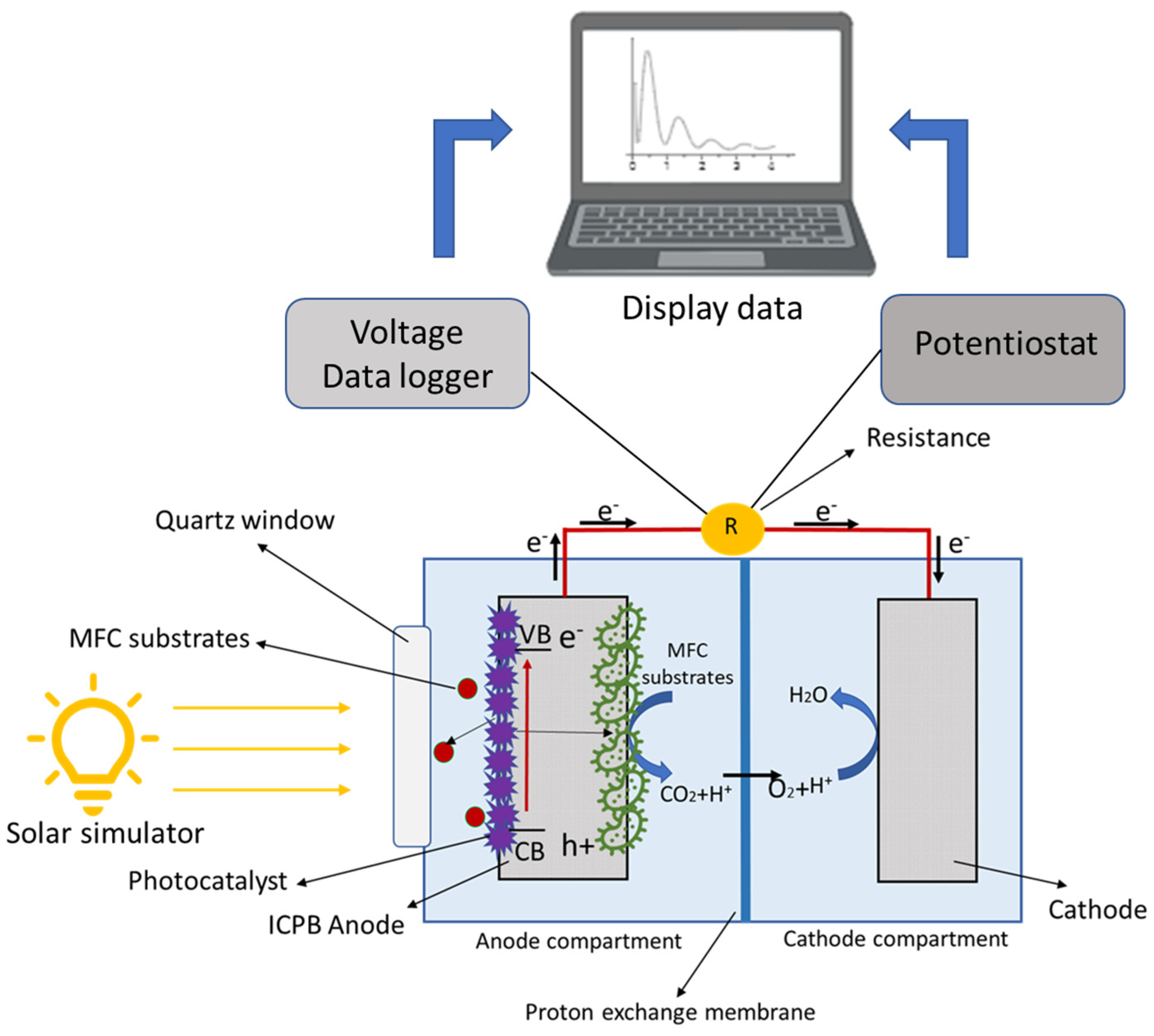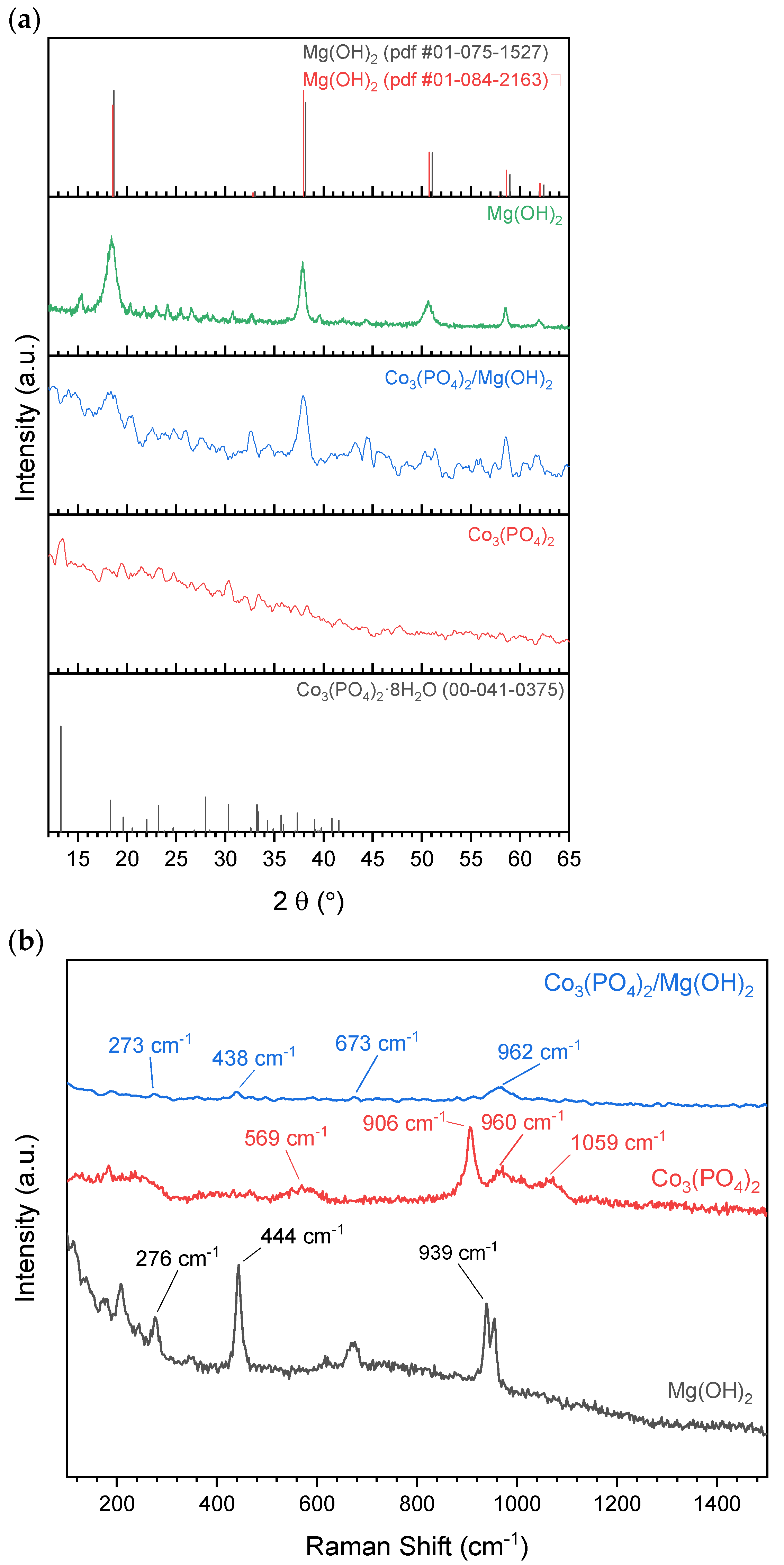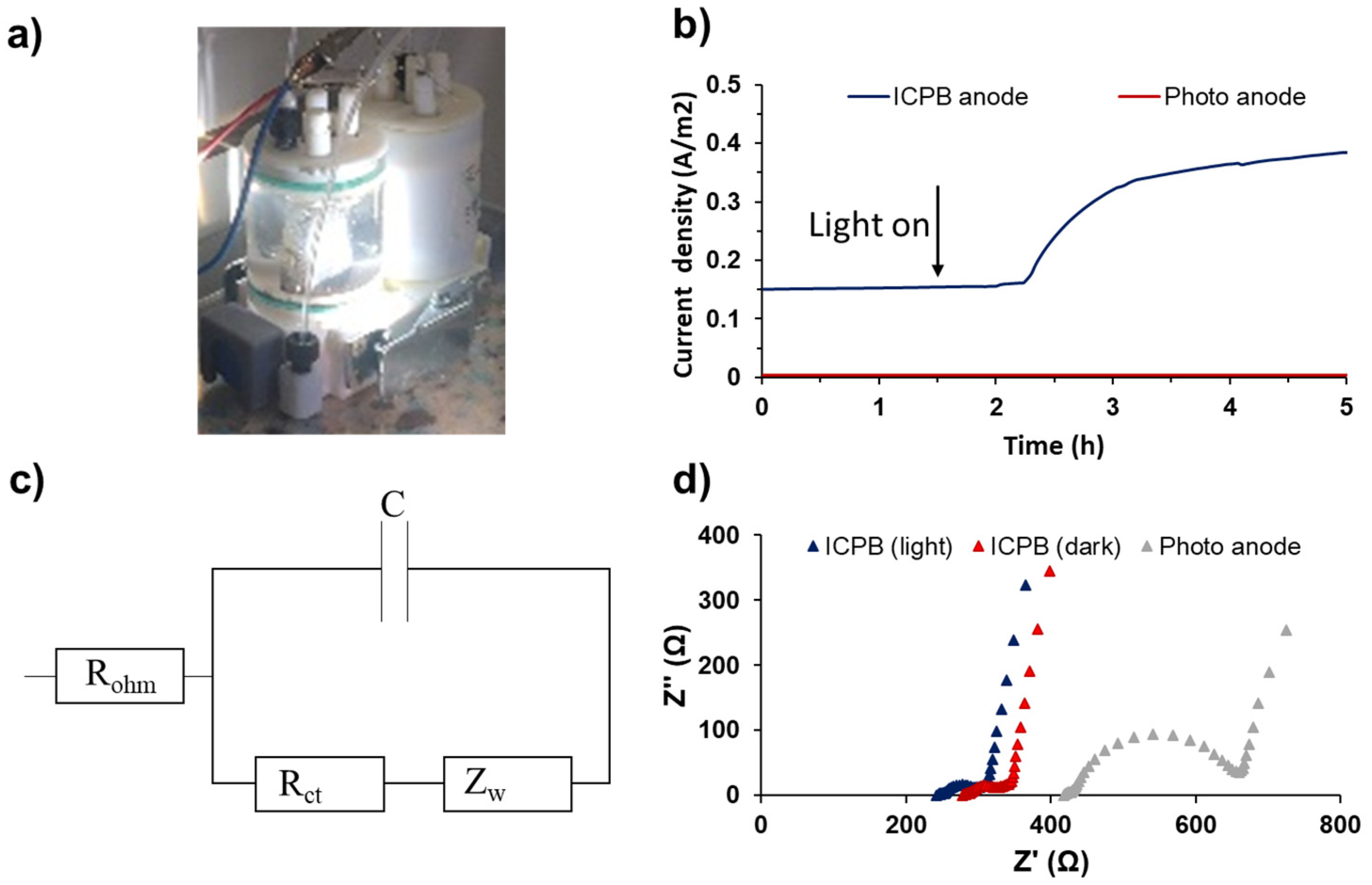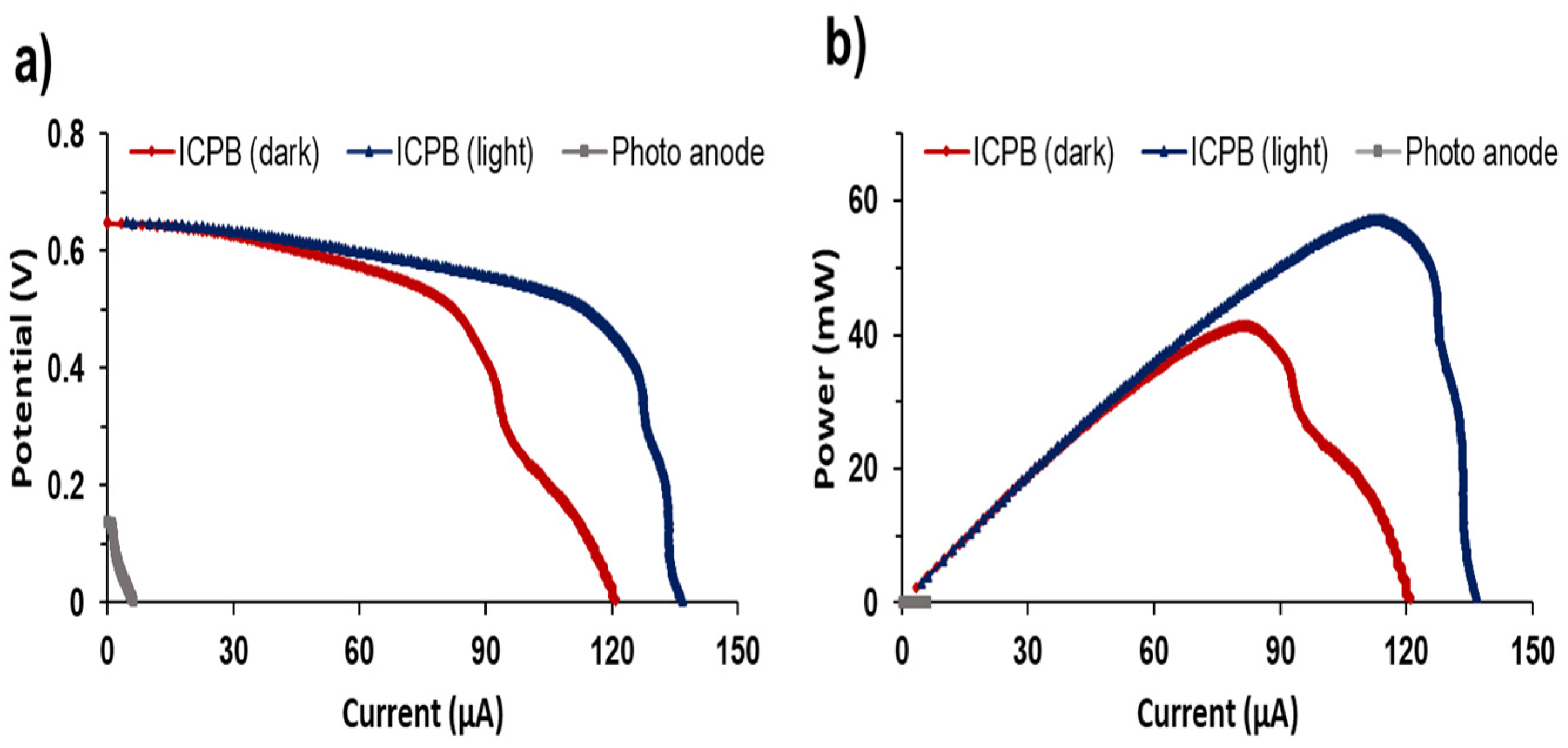Enhanced Electricity Generation in Solar-Driven Photo-Bioelectrochemical Cells Equipped with Co3(PO4)2/Mg(OH)2 Photoanode
Abstract
:1. Introduction
2. Materials and Methods
2.1. Chemicals
2.2. Photocatalyst Synthesis and Characterization
2.3. Enrichment and Acclimatization of EAB
2.4. Integration of Photocatalysis and Biodegradation in s-PBEC
2.5. Electrochemical Analyses
2.6. Microbial Community Analysis
3. Results and Discussion
3.1. Physicochemical Characterization of Photocatalyst
3.2. Co3(PO4)2/Mg(OH)2 Heterojunction ICPB Photoanodes Enhance the Performance of s-PBES
3.3. Microbial Community Analysis
4. Conclusions
Author Contributions
Funding
Data Availability Statement
Conflicts of Interest
Abbreviations
| CB | Conduction Band |
| DRS | Diffuse Reflectance Spectra |
| EAB | Electroactive Bacteria |
| EET | Extracellular Electron Transfer |
| EIS | Electrochemical Impedance Spectroscopy |
| HR-TEM | High-Resolution Transmission Electron Microscope |
| ICPB | Intimate Coupling of Photocatalysis and Biodegradation |
| LSV | Linear Sweep Voltammetry |
| MFC | Microbial Fuel Cells |
| MES | Microbial Electrochemical Systems |
| PL | Photoluminescence |
| ROSs | Reactive Oxygen Species |
| s-PBEC | Solar-driven Photo-Bioelectrochemical Cell |
| TEM | Transmission Electron Microscopy |
References
- Rafieenia, R.; Sulonen, M.; Mahmoud, M.; El-Gohary, F.; Rossa, C.A. Integration of Microbial Electrochemical Systems and Photocatalysis for Sustainable Treatment of Organic Recalcitrant Wastewaters: Main Mechanisms, Recent Advances, and Present Prospects. Sci. Total Environ. 2022, 824, 153923. [Google Scholar] [CrossRef] [PubMed]
- Wahaab, R.A.; Mahmoud, M.; van Lier, J.B. Toward Achieving Sustainable Management of Municipal Wastewater Sludge in Egypt: The Current Status and Future Prospective. Renew. Sustain. Energy Rev. 2020, 127, 109880. [Google Scholar] [CrossRef]
- Rasheed, T.; Bilal, M.; Nabeel, F.; Adeel, M.; Iqbal, H.M.N. Environmentally-Related Contaminants of High Concern: Potential Sources and Analytical Modalities for Detection, Quantification, and Treatment. Environ. Int. 2019, 122, 52–66. [Google Scholar] [CrossRef] [PubMed]
- Yan, Z.; Yang, X.; Lu, G.; Liu, J.; Xie, Z.; Wu, D. Potential Environmental Implications of Emerging Organic Contaminants in Taihu Lake, China: Comparison of Two Ecotoxicological Assessment Approaches. Sci. Total Environ. 2014, 470–471, 171–179. [Google Scholar] [CrossRef] [PubMed]
- Gude, V.G. Wastewater Treatment in Microbial Fuel Cells—An Overview. J. Clean Prod. 2016, 122, 287–307. [Google Scholar] [CrossRef]
- Vinayak, V.; Khan, M.J.; Varjani, S.; Saratale, G.D.; Saratale, R.G.; Bhatia, S.K. Microbial Fuel Cells for Remediation of Environmental Pollutants and Value Addition: Special Focus on Coupling Diatom Microbial Fuel Cells with Photocatalytic and Photoelectric Fuel Cells. J. Biotechnol. 2021, 338, 5–19. [Google Scholar] [CrossRef] [PubMed]
- Mahmoud, M.; Parameswaran, P.; Torres, C.I.; Rittmann, B.E. Fermentation Pre-Treatment of Landfill Leachate for Enhanced Electron Recovery in a Microbial Electrolysis Cell. Bioresour. Technol. 2014, 151, 151–158. [Google Scholar] [CrossRef] [PubMed]
- Khater, D.Z.; Amin, R.S.; Zhran, M.O.; Abd El-Aziz, Z.K.; Mahmoud, M.; Hassan, H.M.; El-Khatib, K.M. The Enhancement of Microbial Fuel Cell Performance by Anodic Bacterial Community Adaptation and Cathodic Mixed Nickel–Copper Oxides on a Graphene Electrocatalyst. J. Genet. Eng. Biotechnol. 2022, 20, 12. [Google Scholar] [CrossRef] [PubMed]
- El-Qelish, M.; Mahmoud, M. Overcoming Organic Matter Limitation Enables High Nutrient Recovery from Sewage Sludge Reject Water in a Self-Powered Microbial Nutrient Recovery Cell. Sci. Total Environ. 2022, 802, 149851. [Google Scholar] [CrossRef] [PubMed]
- Mahmoud, M. Electricity-Driven Microbial Factory for Value-Added Resources Recovery from Waste Streams. In Bioelectrochemical Systems; Volume 1 Principles and Processes; Springer: Singapore, 2020; pp. 119–138. [Google Scholar]
- Santoro, C.; Arbizzani, C.; Erable, B.; Ieropoulos, I. Microbial Fuel Cells: From Fundamentals to Applications. A Review. J. Power Sources 2017, 356, 225–244. [Google Scholar] [CrossRef]
- Mahmoud, M.; El-Khatib, K.M. Three-Dimensional Graphitic Mesoporous Carbon-Doped Carbon Felt Bioanodes Enables High Electric Current Production in Microbial Fuel Cells. Int. J. Hydrog. Energy 2020, 45, 32413–32422. [Google Scholar] [CrossRef]
- Yaqoob, A.A.; Ibrahim, M.N.M.; Guerrero-Barajas, C. Modern Trend of Anodes in Microbial Fuel Cells (MFCs): An Overview. Environ. Technol. Innov. 2021, 23, 101579. [Google Scholar] [CrossRef]
- Feng, H.; Liang, Y.; Guo, K.; Li, N.; Shen, D.; Cong, Y.; Zhou, Y.; Wang, Y.; Wang, M.; Long, Y. Hybridization of Photoanode and Bioanode to Enhance the Current Production of Bioelectrochemical Systems. Water Res. 2016, 102, 428–435. [Google Scholar] [CrossRef] [PubMed]
- Marsolek, M.D.; Torres, C.I.; Hausner, M.; Rittmann, B.E. ARTICLE Intimate Coupling of Photocatalysis and Biodegradation in a Photocatalytic Circulating-Bed Biofilm Reactor. Biotechnol. Bioeng 2008, 101, 83–92. [Google Scholar] [CrossRef] [PubMed]
- Zhou, D.; Dong, S.; Ki, D.; Rittmann, B.E. Photocatalytic-Induced Electron Transfer via Anode-Respiring Bacteria (ARB) at an Anode That Intimately Couples ARB and a TiO2 Photocatalyst. Chem. Eng. J. 2018, 338, 745–751. [Google Scholar] [CrossRef]
- Zhou, D.; Dong, S.; Shi, J.; Cui, X.; Ki, D.; Torres, C.I.; Rittmann, B.E. Intimate Coupling of an N-Doped TiO2 Photocatalyst and Anode Respiring Bacteria for Enhancing 4-Chlorophenol Degradation and Current Generation. Chem. Eng. J. 2017, 317, 882–889. [Google Scholar] [CrossRef]
- Zhu, Q.; Wang, X.; Hu, J.; Chen, S.; Hu, S.; Wu, Y.; Liu, B.; Xiao, K.; Liang, S.; Yang, J.; et al. Efficient Degradation of Refractory Pollutant in a Microbial Fuel Cell with Novel Hybrid Photocatalytic Air-Cathode: Intimate Coupling of Microbial and Photocatalytic Processes. Bioresour. Technol. 2021, 340, 125717. [Google Scholar] [CrossRef] [PubMed]
- Wang, X.; Hu, J.; Chen, Q.; Zhang, P.; Wu, L.; Li, J.; Liu, B.; Xiao, K.; Liang, S.; Huang, L. Synergic Degradation of 2, 4, 6-Trichlorophenol in Microbial Fuel Cells with Intimately Coupled Photocatalytic-Electrogenic Anode. Water Res. 2019, 156, 125–135. [Google Scholar] [CrossRef] [PubMed]
- Wang, C.; Wu, G.; Zhu, X.; Xing, Y.; Yuan, X.; Qu, J. Synergistic Degradation for O-Chlorophenol and Enhancement of Power Generation by a Coupled Photocatalytic-Microbial Fuel Cell System. Chemosphere 2022, 293, 133517. [Google Scholar] [CrossRef]
- Antolini, E. Photoelectrocatalytic Fuel Cells and Photoelectrode Microbial Fuel Cells for Wastewater Treatment and Power Generation. J. Environ. Chem. Eng. 2019, 7, 103241. [Google Scholar] [CrossRef]
- Yu, M.; Wang, J.; Tang, L.; Feng, C.; Liu, H.; Zhang, H.; Peng, B.; Chen, Z.; Xie, Q. Intimate Coupling of Photocatalysis and Biodegradation for Wastewater Treatment: Mechanisms, Recent Advances and Environmental Applications. Water Res. 2020, 175, 115673. [Google Scholar] [CrossRef]
- Wang, H.; Liu, X.; Niu, P.; Wang, S.; Shi, J.; Li, L. Porous Two-Dimensional Materials for Photocatalytic and Electrocatalytic Applications. Matter 2020, 2, 1377–1413. [Google Scholar] [CrossRef]
- Gan, X.; Lei, D.; Wong, K.-Y. Two-Dimensional Layered Nanomaterials for Visible-Light-Driven Photocatalytic Water Splitting. Mater. Today Energy 2018, 10, 352–367. [Google Scholar] [CrossRef]
- Zhu, M.; Han, M.; Zhu, C.; Hu, L.; Huang, H.; Liu, Y.; Kang, Z. Strong Coupling Effect at the Interface of Cobalt Phosphate-Carbon Dots Boost Photocatalytic Water Splitting. J. Colloid Interface Sci. 2018, 530, 256–263. [Google Scholar] [CrossRef]
- Wang, B.-J.; Li, X.-H.; Cai, X.-L.; Yu, W.-Y.; Zhang, L.-W.; Zhao, R.-Q.; Ke, S.-H. Blue Phosphorus/Mg(OH)2 van Der Waals Heterostructures as Promising Visible-Light Photocatalysts for Water Splitting. J. Phys. Chem. C 2018, 122, 7075–7080. [Google Scholar] [CrossRef]
- Mahmoud, M.; Torres, C.I.; Rittmann, B.E. Changes in Glucose Fermentation Pathways as a Response to the Free Ammonia Concentration in Microbial Electrolysis Cells. Environ. Sci. Technol. 2017, 51, 13461–13470. [Google Scholar] [CrossRef]
- Tamames, J.; Puente-Sánchez, F. SqueezeMeta, A Highly Portable, Fully Automatic Metagenomic Analysis Pipeline. Front. Microbiol. 2019, 9, 425882. [Google Scholar] [CrossRef]
- Li, D.; Liu, C.-M.; Luo, R.; Sadakane, K.; Lam, T.-W. MEGAHIT: An Ultra-Fast Single-Node Solution for Large and Complex Metagenomics Assembly via Succinct de Bruijn Graph. Bioinformatics 2015, 31, 1674–1676. [Google Scholar] [CrossRef]
- Wu, Y.-W.; Simmons, B.A.; Singer, S.W. MaxBin 2.0: An Automated Binning Algorithm to Recover Genomes from Multiple Metagenomic Datasets. Bioinformatics 2016, 32, 605–607. [Google Scholar] [CrossRef] [PubMed]
- Kang, D.D.; Li, F.; Kirton, E.; Thomas, A.; Egan, R.; An, H.; Wang, Z. MetaBAT 2: An Adaptive Binning Algorithm for Robust and Efficient Genome Reconstruction from Metagenome Assemblies. PeerJ 2019, 7, e7359. [Google Scholar] [CrossRef] [PubMed]
- Shao, H.; Padmanathan, N.; McNulty, D.; O′Dwyer, C.; Razeeb, K.M. Supercapattery Based on Binder-Free Co3(PO4)2·8H2O Multilayer Nano/Microflakes on Nickel Foam. ACS Appl. Mater. Interfaces 2016, 8, 28592–28598. [Google Scholar] [CrossRef]
- Li, J.; Zhang, L.; Yang, P.; Cheng, X. Morphological Evolution of Co Phosphate and Its Electrochemical and Photocatalytic Performance. CrystEngComm 2018, 20, 6982–6988. [Google Scholar] [CrossRef]
- Kang, J.; Keikhaei, M.; Li, T.; Ichimura, M. Galvanostatic Electrochemical Deposition of Cu-Doped Mg(OH)2 Thin Films and Fabrication of Pn Homojunction. Mater. Res. Bull. 2021, 137, 111207. [Google Scholar] [CrossRef]
- Aggoun, K.; Chaal, L.; Creus, J.; Sabot, R.; Saidani, B.; Jeannin, M. Marine Corrosion Resistance of CeO2/Mg(OH)2 Mixed Coating on a Low Alloyed Steel. Surf. Coat. Technol. 2019, 372, 410–421. [Google Scholar] [CrossRef]
- Suslu, A.; Wu, K.; Sahin, H.; Chen, B.; Yang, S.; Cai, H.; Aoki, T.; Horzum, S.; Kang, J.; Peeters, F.M. Unusual Dimensionality Effects and Surface Charge Density in 2D Mg (OH)2. Sci. Rep. 2016, 6, 20525. [Google Scholar] [CrossRef]
- Saratale, R.G.; Saratale, G.D.; Pugazhendhi, A.; Zhen, G.; Kumar, G.; Kadier, A.; Sivagurunathan, P. Microbiome Involved in Microbial Electrochemical Systems (MESs): A Review. Chemosphere 2017, 177, 176–188. [Google Scholar] [CrossRef]
- Logan, B.E.; Regan, J.M. Electricity-Producing Bacterial Communities in Microbial Fuel Cells. Trends Microbiol. 2006, 14, 512–518. [Google Scholar] [CrossRef]
- Ahtesham, A.; Shahadat, M.; Hussain, E.; Adnan, R.; Ahammad, S.Z.; Jain, R.; Raees, K. Treatment of Antibiotic-Resistant Genes via Photocatalytic-Assisted Microbial Fuel Cells: A Review. J. Water Process Eng. 2023, 55, 104126. [Google Scholar] [CrossRef]
- Guan, J.; Cao, X.; Yuan, Y.; Wang, C.; An, R.; Lu, P.; Lu, N. Synergic Mechanisms of Electricity Generation and Bisphenol a Degradation in a Novel Photocatalytic-Microbial Fuel Cell Equipped with a TiO2-C-BiVO4 Photo-Anode and a Biofilm-Anode. Chem. Eng. J. 2023, 471, 144308. [Google Scholar] [CrossRef]
- Xu, Y.; Zhang, N.; Yang, G.; Chang, Y.; Wang, D.; Xia, J. Degradation Mechanisms and Microbial Community Analysis of Cefalexin in the Intimately Coupled Photocatalytic and Biodegradation System. Energy Rep. 2023, 9, 206–218. [Google Scholar] [CrossRef]
- Long, X.; Wang, H.; Wang, C.; Li, X. The Synergistic Effect of Biophoto Anode for the Enhancement of Current Generation and Degradation. Environ. Technol. 2020, 41, 3420–3430. [Google Scholar] [CrossRef]
- Hou, Y.; Yuan, G.; Qin, S.; Tu, L.; Yan, Y.; Yu, Z.; Lin, H.; Chen, Y.; Zhu, H.; Song, H.; et al. Photocathode Optimization and Microbial Community in the Solar-Illuminated Bio-Photoelectrochemical System for Nitrofurazone Degradation. Bioresour. Technol. 2020, 302, 122761. [Google Scholar] [CrossRef]
- Rafieenia, R.; Mahmoud, M.; El-Gohary, F.; Avignone Rossa, C. The Degradation of Glyphosate Is Enhanced in a Microbial Fuel Cell: Electrochemical Performance, Degradation Efficiency, and Analysis of the Anodic Microbial Community. Sustain. Energy Technol. Assess. 2022, 54, 102805. [Google Scholar] [CrossRef]
- Yang, Y.; Pratap Singh, R.; Song, D.; Chen, Q.; Zheng, X.; Zhang, C.; Zhang, M.; Li, Y. Synergistic Effect of Pseudomonas Putida II-2 and Achromobacter Sp. QC36 for the Effective Biodegradation of the Herbicide Quinclorac. Ecotoxicol. Environ. Saf. 2020, 188, 109826. [Google Scholar] [CrossRef]
- Safdari, M.-S.; Kariminia, H.-R.; Ghobadi Nejad, Z.; Fletcher, T.H. Study Potential of Indigenous Pseudomonas Aeruginosa and Bacillus Subtilis in Bioremediation of Diesel-Contaminated Water. Water Air Soil Pollut. 2017, 228, 1–7. [Google Scholar] [CrossRef]
- Petriglieri, F.; Singleton, C.M.; Kondrotaite, Z.; Dueholm, M.K.D.; McDaniel, E.A.; McMahon, K.D.; Nielsen, P.H. Reevaluation of the Phylogenetic Diversity and Global Distribution of the Genus “Candidatus Accumulibacter”. mSystems 2022, 7, e00016–e00022. [Google Scholar] [CrossRef]
- Li, Z.; Wang, X.; Ma, B.; Wang, S.; Zheng, D.; She, Z.; Guo, L.; Zhao, Y.; Xu, Q.; Jin, C.; et al. Long-Term Impacts of Titanium Dioxide Nanoparticles (TiO2 NPs) on Performance and Microbial Community of Activated Sludge. Bioresour. Technol. 2017, 238, 361–368. [Google Scholar] [CrossRef]
- Jia, Y.; Zeng, W.; Fan, Z.; Meng, Q.; Liu, H.; Peng, Y. An Effective Titanium Salt Dosing Strategy for Phosphorus Removal from Wastewater: Synergistic Enhancement of Chemical and Biological Treatment. Sci. Total Environ. 2022, 842, 156960. [Google Scholar] [CrossRef]
- Leibeling, S.; Schmidt, F.; Jehmlich, N.; von Bergen, M.; Müller, R.H.; Harms, H. Declining Capacity of Starving Delftia Acidovorans MC1 to Degrade Phenoxypropionate Herbicides Correlates with Oxidative Modification of the Initial Enzyme. Environ. Sci. Technol. 2010, 44, 3793–3799. [Google Scholar] [CrossRef]
- Subhash, Y.; Park, M.-J.; Lee, S.-S. Microvirgula Curvata Sp. Nov., Isolated from Hydrocarbon-Contaminated Soil, and Emended Description of the Genus Microvirgula. Int. J. Syst. Evol. Microbiol. 2016, 66, 5309–5313. [Google Scholar] [CrossRef] [PubMed]
- Sauvetre, A.; Schroder, P. Uptake of Carbamazepine by Rhizomes and Endophytic Bacteria of Phragmites Australis. Front. Plant Sci. 2015, 6, 128336. [Google Scholar] [CrossRef]







Disclaimer/Publisher’s Note: The statements, opinions and data contained in all publications are solely those of the individual author(s) and contributor(s) and not of MDPI and/or the editor(s). MDPI and/or the editor(s) disclaim responsibility for any injury to people or property resulting from any ideas, methods, instructions or products referred to in the content. |
© 2024 by the authors. Licensee MDPI, Basel, Switzerland. This article is an open access article distributed under the terms and conditions of the Creative Commons Attribution (CC BY) license (https://creativecommons.org/licenses/by/4.0/).
Share and Cite
Rafieenia, R.; Mahmoud, M.; Abdel-Wahed, M.S.; Gad-Allah, T.A.; Salvian, A.; Farkas, D.; El-Gohary, F.; Avignone Rossa, C. Enhanced Electricity Generation in Solar-Driven Photo-Bioelectrochemical Cells Equipped with Co3(PO4)2/Mg(OH)2 Photoanode. Water 2024, 16, 1683. https://doi.org/10.3390/w16121683
Rafieenia R, Mahmoud M, Abdel-Wahed MS, Gad-Allah TA, Salvian A, Farkas D, El-Gohary F, Avignone Rossa C. Enhanced Electricity Generation in Solar-Driven Photo-Bioelectrochemical Cells Equipped with Co3(PO4)2/Mg(OH)2 Photoanode. Water. 2024; 16(12):1683. https://doi.org/10.3390/w16121683
Chicago/Turabian StyleRafieenia, Razieh, Mohamed Mahmoud, Mahmoud S. Abdel-Wahed, Tarek A. Gad-Allah, Anna Salvian, Daniel Farkas, Fatma El-Gohary, and Claudio Avignone Rossa. 2024. "Enhanced Electricity Generation in Solar-Driven Photo-Bioelectrochemical Cells Equipped with Co3(PO4)2/Mg(OH)2 Photoanode" Water 16, no. 12: 1683. https://doi.org/10.3390/w16121683






